Guts of the Gun – The Revolver
Nostalgic Throwback or Modern Performer?
By Brian Jensen
 |
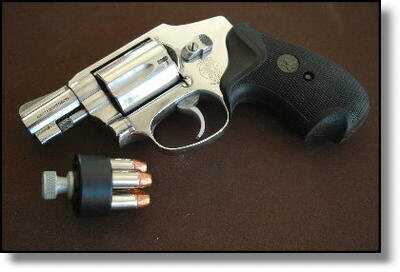 |
The modern revolver is still a potent and viable option as a defensive too. Reliability, ease of use, and durability all combine to make a fine handgun. Smith & Wesson, Ruger, and Taurus are all very strong in the self defense market. |
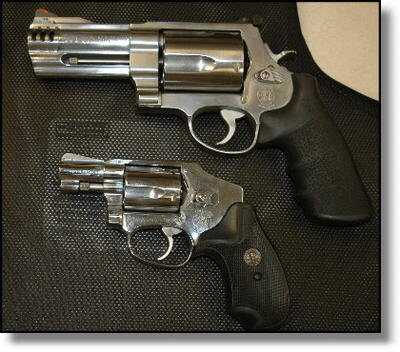 |
Revolvers come in all sizes. The Smith & Wesson 500 is chambered for the .500 S&W cartridges (above) and the .38 Sp. J-Frame snubbie (below). |
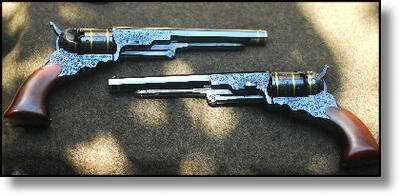 |
Colt Patterson Revolver pair (modern Colt replica) for sale on GunsAmerica. |
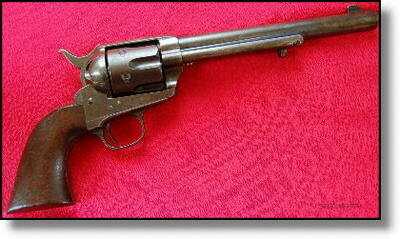 |
This is a period Colt SAA (Peacemaker) I found for sale on GunsAmerica today. It is from before smokeless powder and could probably tell quite a story. |
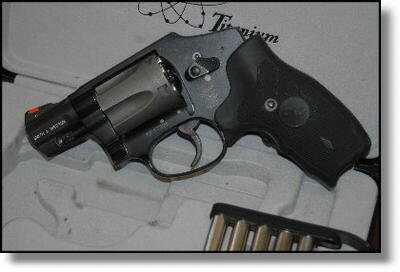 |
This scandium/titanium revolver is light, durable, and easy to carry. (It is however, painful to shoot.) |
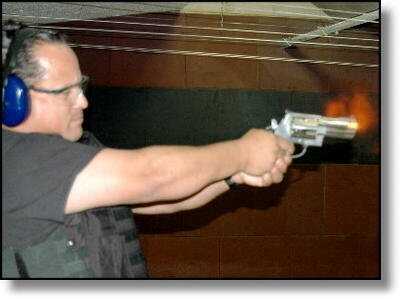 |
The 500 Smith and Wesson while firing; this cannon is not for the faint of heart, even with the muzzle brake. |
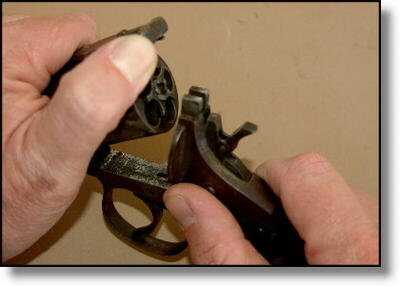 |
The break top revolver was an early way to load a revolver more quickly. It’s drawback was the break-top design made for a weaker frame and is not generally suited for the hotter cartridges. NOTE: Do not fire .38 Special in a .38S&W break top revolver. |
 |
The Taurus Judge “Public Defender” is a handful of dynamite in a very exciting, controllable and affordable package. These go for around $500 on GunsAmerica. |
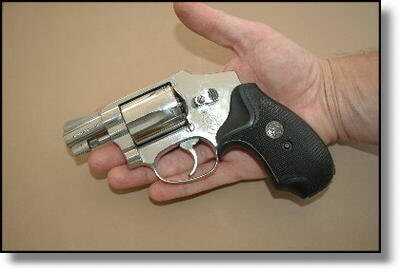 |
The size of the 5-shot revolver lends itself to concealment, but gives five shots of reliable firepower. |
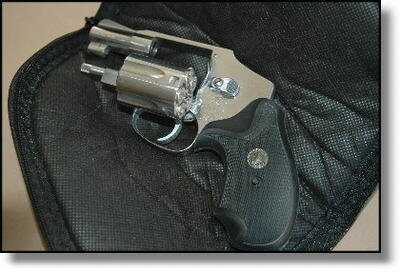 |
One of the great advantages of a revolver is the ability to sit loaded and ready over time. There are no magazine springs to worry about. |
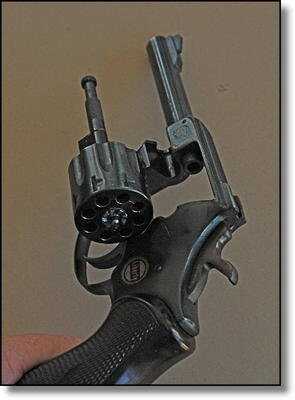 |
The revolver is generally thought of as a “six shooter”. However, this .22 holds eight rounds. Others are found regularly with seven shots. |
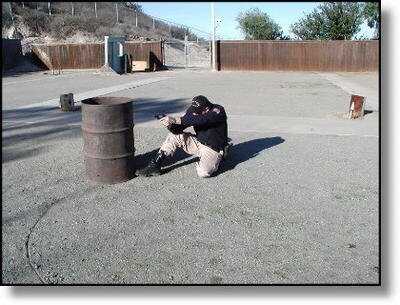 |
The small snub-nosed revolver is well regarded in law enforcement and CCW circles as a rugged, reliable, and easily concealed defensive handgun. |
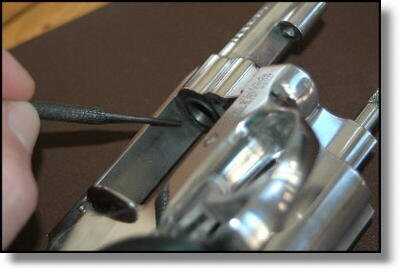 |
When looking at a used revolver, the buyer should check for “flame cutting” or erosion in the area of the top-strap above the forcing cone. |
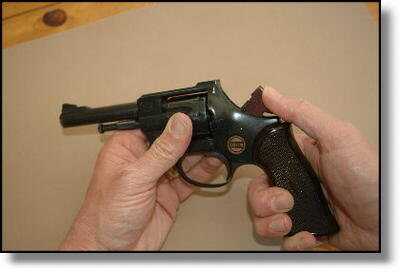 |
Another test for a used revolver is to check the “timing and lockup” as the cylinder lines up with the forcing cone of the revolver. Once you’ve assured the gun is unloaded, pull back the hammer, and see that the cylinder is lined up with the barrel, then try to see if the cylinder moves from side to side. If it’s locked up tight, and lines up right, you should be good. |
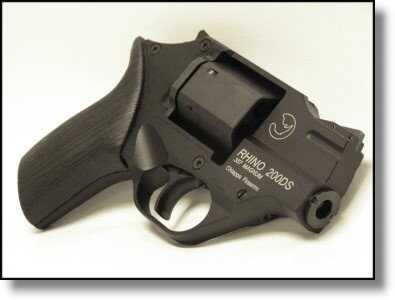 |
The Chiappa Rhino has taken the revolver, and taken it “outside the box”. It uses flats on the cylinder and along the barrel to make a flatter profile for concealed carry. These guns come in a 6-shot .357 magnum setup of varying barrel lengths. Makes you think of what revolvers we’ll see in the future. |
OK…I’m not afraid to admit it; I grew up watching shows like Starsky and Hutch as a kid. The single coolest point of that show was watching “Hutch” pull out that 6-inch Colt Python – probably one of the highest “cool factor” pistols out at the time. As I recall, every cop and detective show from Andy Griffith to Cannon had the hero carrying a trusty wheelgun into harms way back then.
Yet now, when I train new officers, I show them my J-Frame snubbie and they give me a look something like that old Steve Martin – Bill Murray skit from Saturday Night Live, “What the Hell is that Thing…”
It’s true, if you ask most new gun buyers who are looking for their first handgun, my experience has been that they want some semi auto, and they look at the revolver as some antiquated piece of history. Oh how wrong they are. The revolver is still a viable, potent, and downright best choice for many applications, and for the majority of shooters.
A Little History…
The first revolving pistol is a matter of dispute, but in America we credit Sam Colt with its invention. In 1836 the Colt Patterson was released and quickly adopted by famous Texas Ranger Jack Hayes. The gun was notorious for its underpowered .36 caliber ball and for falling apart, but it was the first, and it worked. It was later followed by several models from Colt, Remington and others through the Civil War and into the 1870s. Last month we had a very good overview of shooting replicas of these fine and effective firearms. In 1873, Colt evolved the next generation of the revolver with the brass cartridge firing Colt Peacemaker, or Single Action Army, the civilian and military designations respectively. Then in the 1890s, when smokeless gunpowder took the place of crude, dirty, corrosive and smelly black powder, the revolver became a mainstay of American firearms.
During those years (the first were actually percussion revolvers), several manufacturers introduced the concept of “double action” revolvers, where the pull of the trigger simultaneously cocked and fired the weapon. When you think of a modern revolver used for self defense, like a Smith & Wesson or the new Ruger LCR, you generally will be thinking double action. Single action revolvers still have their place, and General Patton is famous for carrying Colt Single Action Armies, but most would class a single action revolver as primarily a target, collectible, or replica weapon, not something built for modern day self defense.
How it Works
Revolvers work on a simple concept. Multiple chambers rotate and are aligned with the barrel and firing pin individually, each getting its turn. The pistol’s hammer is cocked (either by pulling back the hammer manually, or the trigger pulling back the hammer as it is pulled) and the mechanism rotates the cylinder with the next loaded chamber into a firing position at the rear of the barrel. The hammer falls, and strikes the round’s primer directly with an integral firing pin, or with a captured pin in the frame which fires the gun. The shooter then repeats this to rotate the cylinder and fire again.
The bullet, once fired, exits the cylinder, and enters an area called the “forcing cone” of the pistol’s barrel which guides the bullet into the bore, and sends it on it’s way to the target. The empty casings remain in the cylinder until the shooter cracks open the action and they either are dumped or pulled out, depending on which type of revolver it is.
Revolvers are loaded by ejecting the empties from the chambers in the cylinder and reloading these chambers with new rounds. Some cylinders are fixed in the gun – such as in single-action revolvers, and reloaded one at a time by a loading gate at the rear of the frame. Others, from the turn of the century and before would “break open” to access the rear of the cylinder and eject the empties (the Iver Johnson hardware store gun era). The most common modern system is the swing out cylinder, which also gives full access to the rear of the chambers to load them. The swing out is now universal in double action revolver design.
The Love of Revolvers
There is a mystique about revolvers that is very hard to put into words.
Unless you have been living under a rock and never seen a western movie, this is the pistol we will all remember from the Old West. And even though the double action revolver has eclipsed the era of the single action, there are still several national shooting clubs that celebrate the history of these history and effective weapons. The most prolific, with hundreds of thousands of members, is the Single Action Shooting Society, where competitors show up in full old west regalia. It isn’t a costume contest though. They shoot at steel plates on a timer, and the speeds can be blinding.
Remember that with a single action revolver, you fire it by first cocking the hammer, then the shooter pulls the trigger to release the hammer from where it’s held, letting it fall forward. The firing pin on the hammer then strikes the cartridge’s primer, firing the gun. The shooter then re-cocks the hammer to rotate the cylinder and repeat the firing sequence. Sounds time consuming from a Glock perspective right? Some people can do it fast than they eye can see.
You can still buy a real Colt Peacemaker to this day, and many others make there here in the US and overseas, mostly in Italy.
Ruger has led the way for decades in the area of single action modern revolvers. The Blackhawk series has been enormously successful, as has their Single Six and Vaquero lines, the latter of which was created specifically for the cowboy action, or SASS, shooter.
Dirty Harry and Beyond
Romance isn’t lost on the double action revolver either. Dirty Harry carried the infamous Model 29 Smith & Wesson, in .44 Magnum that could “blow your head clean off”. But the double action revolver is more known for its modern day effectiveness.
The biggest complaint about the double action revolver is also one of its strengths. It has a long, heavy trigger pull. You are after all both cocking then firing the gun, so this takes some work. It is faster to fire a revolver this way than single action, but the heavy pull is thought to effect accuracy. The longer the motion and the more energy expelled the more your hand has a tendency to not stay in one place.
Most double action revolvers can be fired single action at the will of the shooter simply by pulling the hammer rearward into the cocked position. However, there are some versions of double action only revolvers that have a bobbed hammer of no external hammer at all. These are generally concealed defensive pistols, prized for being snag-free without the hammer – they can be concealed and drawn with little in the way of sharp points that can grab onto clothing during the draw. As a police range instructor, I see a whole lot of these carried as backups. They are also highly prized by armed citizens for the same reasons.
The strength of the double action revolver is simplicity of operation, and surprisingly, safety, even though almost all revolvers have no manual safety lever at all. The heavy double action pull makes an accidental discharge almost impossible, and that is why many states mandate them for security guard use where constant training is not required.
Automatic…Yes, Automatic.
OK…I know you’re thinking that this sounds like I’ve jumped ahead to auto pistols, but there are automatic revolvers. The recoil of the weapon as it fires forces the barrel and/or cylinder to move backwards, cocking the hammer for the next shot as a single action trigger pull, much like a semiautomatic pistol. The Webley-Fosbery Automatic Revolver from the early 1900’s was an early version of this system.
The Mateba Revolver, from Italy, is just such an unusual system from recent history. Introduced in 1997 and produced until 2005, these are extremely rare and expensive in the states. Chambered in calibers from .357 Magnum, to .454 Casull, these may look a little weird, but they are a neat concept. The bore of the weapon sits lower on the weapon, firing from the bottom chamber in the cylinder. This can help negate some felt recoil by lowering the bore axis.
Extreme Strength
The revolver has one thing that no one will deny; they are just plain strong. Calibers such as .454 Casull, 500 S&W, or 44 Magnum are almost always in revolvers. (Yes, I know there are a few Magnum Research owners screaming right about now…) The design of a revolver just lends itself to a strong and sturdy platform for just such calibers.
I have fired the Smith & Wesson 500 and it is a beast to handle. It is not for the faint of heart, but it has it’s applications I guess. An extremely popular revolver of late has been the Taurus Judge. The “Public Defender” comes in .45LC, but it also holds the .410 shotshell. Several companies have come out with 3 buckshot loads just for the Judge and it is a formidable weapon.
Bulletproof Reliability
When I first became an officer and started carrying a gun for a living almost twenty years ago, the first pistol I bought was a revolver as a backup weapon. Why, because the revolver is the single most reliable weapon I have ever dealt with, bar none. Gun for gun a revolver will take more abuse than any other type of handgun. In fact, a five shot revolver is one of the most common CCW weapons I know of, especially as a backup weapon for police. I have heard the expression used often of “five for sure” to describe the little wheelgun, and it’s a reputation it has earned. In almost thirty years of shooting I have never seen a revolver jam.
The revolver also has a unique advantage over semi-auto pistols as a home defense or house gun, that is just stored, and not necessarily fired on a regular basis. The revolver can sit loaded, and stay ready for as long as the ammo will last without a fear of jamming (excepting rust or other such calamity). While most semi-autos say they can remain fully loaded without compromising their magazine’s spring, I have seen too many magazines fail under these conditions. For a revolver, there are no springs to worry about. The rounds just sit in the cylinder until needed. Don’t get me wrong, I am never a proponent of leaving any gun loaded for your defense for extended periods of time without maintenance, but the revolver can do this without issue.
A Deal on the Used Market
Another great thing about revolvers is they represent a great value in the used gun market. If you shop GunsAmerica there will always be a Smith & Wesson Model 10, Model 66, or even an ugly J-Frame for cheap. A used revolver will generally be easier to check for wear and tear. Lots of guns have carry wear, like pocks of pits on the cylinder and frame, or outright existing rust. But these aren’t functional and can easily be cleaned up.
As long as the cylinder locks up correctly to place each cylinder in line with the barrel (what we call “timing”) and there is no flame cutting or erosion on the topstrap, they generally are good to go. Their rugged construction helps them last longer as well, at least in my experience. With the widespread adoption of auto’s for local police agencies, there will be likely plenty of these out on the used gun market for the foreseeable future. Almost every cop in the country carried a Smith & Wesson Model 10 in the 1930s through the 1970s. Those are all out on the used market and work great.
CCW-A New Era
Smith and Wesson sells many revolvers in their lineup. However, in a recent exchange I had with a S&W executive, it was clear that the small five-shot J-Frame is likely their best seller. The Ruger LCR, a polymer framed gun, has had enormous success, and Taurus has had a strong following for many years with revolvers mostly tailored to the similar Smith & Wesson profiles. These newer guns come in such potent calibers as .357 Magnum or 10mm for the most determined adversary, and are made to be as light as 10.4 ounces, in titanium believe it or not.
All of the above make for a concealed carry wonderland. If you want a nostalgic, blued steel revolver, they have one. If you want a light have one of those as well (they kick a lot more though). Small revolvers, especially the hammerless variety, have the ability to be fired from inside a pocket, repeatedly. Try that with a semi-auto without it jamming. (OK…that was a HYPOTHETICAL statement for anyone who had any bright ideas.)
Cons:
OK, the revolver does lack one thing: capacity. My smallest auto carries seven rounds, while my revolver carries five. Along with this, they are somewhat slower to reload. I can slap a new magazine into a semi-auto pistol quicker than I can use a speedloader or speed strip to reload my revolver. Unless you’re Jerry Miculek, you won’t be that quick. (Insert Video 2)
Revolvers are also relatively bulky, especially when you get into the larger frames. I’m still trying to figure out how a skinny guy like Clint Eastwood comfortably concealed that 6-inch model 29 in 44 magnum. (OK…yeah I just dated myself…) The revolver’s cylinder is just thick.
That cylinder also has one drawback. If something binds up the cylinder from turning, the gun just won’t shoot. My cousin was a police officer in Southern California when he came upon a suspect at a party who decided to draw his revolver and try to shoot him. My cousin grabbed the revolver around the cylinder and held the gun captive while other officers wrestled the bad guy to the ground. The gun was never able to fire because my cousin had a death grip on that thing, and that cylinder never turned.
Now the real drawback…most new shooters are caught up in the sexy image of the semi-auto pistol. James Bond made the Walther cool, Magnum PI had his Colt 1911, and Sonny Crocket had his Bren 10. With the exception of Cowboys and Dirty Harry, the revolver just is not seen in the same light. But to get caught up in image is a mistake for most casual shooters. Remembering to rack the slide (if you are queezy about keeping a loaded round in the chamber of a Glock) at 2am when you hear a bang downstairs and you don’t pets, or dropping the safety on your carry 1911 when the 7/11 gets robbed in front of you is not something you are always going to remember unless you shoot your weapon a lot. Revolvers are the best choice for the majority of shooters.
The Modern Revolver is Alive and Well…
I’ve already mentioned the Smith and Wesson, Ruger, and Taurus. However, that’s just the tip of the iceberg. Revolvers run the gamut in value, from a Charter Arms or Rossi which can run in the $300 range to a Colt Python which can head well over $3,000. That can even be eclipsed by some of the older, collectable Colt Single Action guns from the 1800’s.
A new, and particularly interesting revolver is from Chiappa Firearms of Dayton Ohio, called the Rhino. These .357 magnum 6-shots are made in Italy by Kimar, and feature several characteristics that take the revolver into the next generation. The Rhino has a barrel which fires from the bottom cylinder, allowing the bore axis to sit low in the hand, and reduce felt recoil. The sides of the barrel, and even the cylinder have flats, instead of rounded edges, making for a more concealable package more like a semi-auto. They also have different grip sizes to best fit the gun to you.
Is a Revolver for You?
After reading this, you may find yourself asking if a revolver is for you? They are excellent weapons, and unfortunately they seem often overlooked in light of the modern auto pistol. However, they are a rugged and reliable weapon that can be found in the most potent of calibers.
Consider the role you are looking for. Hunting, defense, or sport . In all you will find revolvers readily able to handle the job. In fact, some are the exclusive domain of the wheelgun, such as cowboy action shooting or hunting for dangerous game with a weapon in a 454 Casull. Perhaps you want something small for carrying concealed. Guess what, cops have carried them for decades and been amply armed.
The revolver is a pillar in the history of modern firearms, but it isn’t simply a relic of old technology. Simplicity, safety and reliability can’t be matched by any other firearm to this day, and a revolver might just be the right gun for you.

Very good article.
Revolvers are just as good as any other firearms.
Like anything else, one must always be familiar and certain about
his weapons. Especially the ones that are in duty at all times.
I no longer shoot competitively but I do maintain regular practice
(NRA shooting range) and keep my guns and ammo in top shape.
My carry piece is loaded with only the carefully tested ammo that
will not fail. I will never carry a dirty gun. I unload and clean all
moving parts every month. Even if the gun was not cycled.
I think of it as my third appendage.
I carry a Colt D.S. or Agent. The latter being much lighter than the D.S. I do own many semi-auto’s, but my concern with them is a jam, that would need to be cleared. My left arm is paralyzed. Hence forth, a revolver only makes sense to me, as I open the cylinder, dump the empties, insert the speed loader, twist, and I’m back in action.
I have learned to use both the speed loader, and speed strips for the revolver. I have also learned how to be an accomplished shootist, with both the revolver, and semi-auto. I have had jams with the semi’s on the range, which required a shooting partner to clear it. As a result of these, I choose the revolver.
I shoot twice a week as a rule, burning up 100 rnds per week. I shoot for accuracy, and I also shoot speed loads. Those are shot at close range, and I am very critical about my shooting. I have to be. I couldn’t afford to miss, if (God forbid) I need to utilize my carry piece.
Nice article to have
I would defer to Ayoob on most things. The thing that puts the Judge and similar on my no list is the size and weight. I want the smallest, lightest, most reliable pocket gun in the world, which accepts a round that passes the FBI test and is Dr. Roberts approved. See http://ammo.ar15.com/project/Self_Defense_Ammo_FAQ/index.htm
So for me, it’s a 340PD with short barrrel gold dot, about 14oz’s loaded. FINALLY a CCW weapon that goes in the pocket without pulling your pants down on that side !!!
Brian, You bring up some great points on revolvers. I own both revolvers and semi-auto’s. Although my 1911 in 45acp is a very trusted friend, I know my model 66 and model 60 S&W’s will go bang when I pull the trigger. Revolvers do have occasional problems but the incidence is so seldom in comparison to even the best semi-auto designs to be insignificant. The Taurus Judge looks to be a terrific home defense weapon inspite of Dr. Smith’s misconceptions on the 410 and 45 colt. However I do have concerns about the quality of Taurus firearms. My father taught me when buying guns to get the absolute best you can afford. I have heard both good and bad about taurus handguns but enough problems have popped up to keep me from buying one.
“…in spite of Dr. Smith’s misconceptions on the 410 and 45 colt.”
If you read my comment, I am quoting Massad Ayoob and Frank C. Barnes. I don’t believe two of the foremost experts in the world have very many ‘misconceptions’.
I wonder if either of them would care to be shot with one? I also wonder if either of them would rather be unarmed than carry a .410/.45 LC?
Several of the best things about revolvers were not mentioned.
Great for people who lack the strength to rack a pistols slide.
Easy effective dry fire practice.
Very easy maintenace. You can check your weapon out while sitting on the commode at a truck stop without worrying about extracting a round and dripping it or dropping a magazine. Springs won’t go flying accross the room
Ability to shoot very light practice rounds or strange shaped bullets. Pistols are ammo sensitive.
Able to be shot from a pocket.
You don’t leave a mess after shooting. Empty brass is easy to pick up and retain
Simplicity is vital for defence (Esp. for shooters who don’t live at the range..) There is perhaps no easier firearm system to get to know than a basic no frills (but well-made) double action revolver A Smith Model 10 w/a 4 inch Bull Barrel is an excelent example. (for Colt fans the Official Police is equv.) While the .38 Spl HAS been assulted in the past, A modern Model 10 (Mine is a 10-8) is rated for +P ammo and modern defence oriented loads Will NOT leave you “Undergunned”. a gun of the Model 10 type has no safeties to forget,no adjustable sights to get out of line and a medium frame revolver with a 4 inch barrel can be well shot by almost any one (My mother was barely 5 ft nothing and shot one well!) Ofcourse TRAINING on ANY GUN is VITAL! All that said, to those who think that guns of this type are “not enough” Remember the Police used them for 100 years and they were used in EVERY war from WWI to Viet Nam! P.S. Revolvers don’t neew “work” to handel wadcutters,hollowpoints ETC!
My favorites include the Colt Diamondback .38 Special and the S&W Model 19 .357 Both are dependable, and will “get the job done”.
YEA_______For those old and new revolvers,I think about those days past,while in law-enforcement when I would take my old K-model master piece .38 out on an old country road,pick up some discarded coke cans toss one out and roll it till she was empty reload and do it again. When my pockets were empty,go home clean her up til the next time. OHHH yes I have some Rugers,Taurus,Bersas,and someeone mentioned a Colt detective special I love it. I also like my Colt Diamond Back.Hey,dont under estimate THE JUDGE it will do some nasty work with those 000 Buck Shot. Got several of those slide-tops also they are a lot of fun too. LOVED THE ARTICLE KEEP UP THE GOOD WORK>
Excellent article. It makes me feel good about my most recent purchase, an S&W Bodyguard for CC. And, unlike my now ex-wife, it won’t file for divorce!
Great article. I’m the senior concealed carry instructor in Louisiana–meaning I’ve been teaching the course longer than anyone on the list–not just that I’m old (also true.)
We’ve trained over 4,000 people in the Louisiana state-certified concealed carry course.
I read articles all the time touting the use of revolvers for self-defense like they are some relic from a bygone age.
When I go in a gun store and hear a clerk behind a counter try to convince a lady that obviously knows nothing about handguns that she should purchase a semi-auto of any caliber, I cringe.
If a person is not going to shoot and practice on a reasonably regular basis, they should NEVER own a semi-automatic for a go-to gun.
I own a small arsenal of pistols and revolvers, carry both a .45 and 9MM in law enforcement on patrol, and when I get out of my POV to walk in Wally-World, the gun in MY jeans is a snubbie 5-shot .38 Special revolver from either Ruger or S&W. And guess what guys? I don’t feel under-gunned at all.
It’s been my experience the guns most guys buy for their girlfriends and wives is the guns THEY want. That’s usually some sort of sexy semi-auto that she is not going to understand, or shoot enough to gain confidence in it.
Defend revolvers? Someone ought to take a good hard look at the ownership of semi-autos, and write a defensive article for them.
Great article! As a Citizen, Hunter, Police Officer, with 15 + years of walking the dark so my fine citizens may sleep quietly in there beds, and most recently, as a Chief, I am also a Firearms Instructor, ILEA, IALEFI, and NRA trained.
The trusted performance of a revolver has touched most every part of my life. Earliest, as a kid raised in northern Wi., a trusty Ruger Single-Six was a constant trapline companion.
As an Officer, a variety of revolvers have been pressed into Duty. As a Reserve and Full time Officer, I have carried an assortment of various revolvers, ranging from the 5” Ruger RedHawks, in .41 and .44mag, when on Duty the .44 loaded with specials for accuracy and control. The S&W revolvers, carried in the line of Duty or backup, in .38/.357, and of my favorite revolvers,an old 4″ S&W 686, powerport, a 5″ S&W 610, chambered in 10mm/.40s&w as well as a 4″ 629 pre-mtn gun Mtn. gun in 44mag. still loaded with specials when not hunting with it.
I have also been fortunate to live in a state that provides for the Handgun hunter, where the .22lr, .357 Max., .10mm, .41, .44 have all been used to harvest game to treat the table or rid the immediate area of vermin.
As a Sport Shooter, I have had the good fortune to meet some of the finest, kindest and most generous people I know at Shooting events, or at a local “range” where it might be as informal as an old quarry, pit or hillside to a member owned, or a run for profit range. Whether officiated by a Range Officer or the un posted basic rules of firearms safety, they all have in common a sense of responsibility to safety, where you as the only person responsible to your sense of personal safety, can choose to, or not to, participate. A place where no one feels offended or afraid to speak up if someone fails to show due respect to the rules of safety. You will find it easy to make a new friend or acquaintance.
As a Firearms Instructor the revolver has been a primary tool in the training/education process of new shooters as well as in the training of some very good ones.
The simplistic statement of, “All Shooting is“; The responsible and orchestrated actions of target identification, and analysis, sight alignment and trigger control to a desired effect, is true enough, but it sure leaves lots of information out of the how to.
When teaching new shooters, there are always some that have a bit of trouble with some part of the “All shooting is.” Sometimes all that is required is for a shooter to take a break, and try a revolver, always on range when I am, to work out the kinks and help shed some light on the problem at hand, no pun intended. When all else is controlled, sight alignment and trigger control can be a simple thing to assess when the movement of the machine is reduced to the press of the trigger and the fall of a hammer in the shooters mind.
While I as a shooter that manages to qualify as required, and one that feels, good enough is never good enough. I am also a shooter that owns or owned and has found a way to defeat most every bad habit known to a shooter. I can milk a grip, anticipate and do most anything but press a clean shot and a half a dozen other things that can mess up a shot,,, and I can do all of this with both hands! Let’s say I might have some insight to how to assist shooters find a way around some of those things that get in the way while they find what works consistently for them. Yep you guessed it, the revolver is just the right tool for that job too.
From a few hours of time well spent with your kids, and the lessons of responsibility, to defending your castle and the loved ones within, to defending your person or that of an innocent or non combatant, a revolver has and will continue to be an important tool, impacting the lives of shooters because it works at getting the job done.
One thing not mentioned in the article is a revolver can be shot from the inside of a coat pocket. You might get one shot from a semi in a pocket. If I feel I am in a dangerous area I can have my S/W .38 in my coat pocket with my hand already on it and finger on the trigger (imminent danger) if needed or on the side. In a shoot out the revolver would have the advantage because my gun is already in my hand ready to shoot except the other person does not know it.
A most excellent article! Revolvers may be considered by some to be a product of “yesterday” or “days gone by”, but they are still a great choice for some shooters. I carry a Glock on duty, but I love my S&W model 10 that I got for a song from a former employer. Keep up the good work! Thanks!!
don;
Meow
apostrophe
Bob J,
I have been a CCW holder for 40 years, and obtained my information regarding the inadequacies of the .410 as a defense round from no less a source than Massad Ayoob. He stated:
“Historically, the .410 shotgun has been a common “starter gun” for shooters, especially younger ones. It is the smallest and lightest “gauge” available. However, many of us think it’s too small. These little shells just don’t hold enough lead to always get the job done. Personally, I see the .410 as a close-range squirrel and rabbit gun. Noted the great Frank C. Barnes in his authoritative text Cartridges of the World, the rifled slug load in the .410 is “not adequate for deer,” though he believed it would get business done with a coyote or bobcat.” http://www.backwoodshome.com/articles2/ayoob110.html
So, if you are facing a deer, coyote or bobcat, great. But in a gunfight against a determined felon, you want a lot more firepower and penetration than that. =)
Excellent article Brian. I’ve owned probably 80 different handguns over the years with the majority being wheelguns. My father raised me in the 50’s and 60’s firmly believing that the difference between a good day and a bad day at the range was whether or not you lost any brass, so I’ve always been a revolver guy because it’s harder to lose brass with one. My go-to carry gun for the last 15 years or so has been a S&W Model 625 Mountain Gun in .45 Long Colt. My father (aged 85) has a 60’s era Colt Detective that I drool over every time I visit him, can’t wait to get my hands on that little gem!
I assume the spell check comment was directed at your use of the apostrophe. A simple fix for your most common apostrophe error is to remember that “it’s” means “it is.” If “it is” doesn’t sound right in your sentence, use “its.” If you wish, I can show you how to correct your other one. Most of my 8th grade English students were able to learn, so it’s not necessary to be a college grad to punctuate correctly.
Now you’ve confused me. According to you, “it’s” means “it is” and I agree and have always used it that way. Then you turn around and say “If “it is” doesn’t sound right in your sentence, use “its.”” (the word “its” implies possession and is therefore not interchangeable with “it is”)
So which is it? If you’re going to correct someone for their punctuation, you had better make sure your corrections are accurate. Grammar police will be knocking on your door shortly!
LOL, nevermind. you can delete these comments because I misunderstood what he was saying!
great article though, keep ’em coming!
Glad to see any article on wheelguns. The articles today all involve semi autos and they all say the same thing except for the maker and model number. I quit reading gun magazines because all they talk about is the semi auto black plastic guns. Don’t misunderstand, my first choice for personal defense/concealed carry is a Sig P 239. But my nightstand gun is a 2-1/2″ S&W model 66 that is customized to me. If I out bumming around in the woods, which I do a lot, I am carrying either a S&W Model 18 in .22 LR or a S&W Model 625 in .45 Colt. Nothing wrong with most semi autos, some of them can even look good and display real class. A revolver has graceful lines and feel like a gun should feel. They also can be dressed up and personalized to suit the carrier/owner. I believe someone besides me made this statement first, but “life is too short to carry an ugly gun.” I think a personal handgun should be like a good wife, able to easily handle any task within her design specs and it sure don’t hurt if she is a little bit pretty too !!
Hear, hear! I’m retired from Baltimore PD and my backup/off duty was a SW concealed hammer. A great weapon to have if/when you need it. I have never known a revolver to jam and never felt I needed more then the 5 rounds I had in my back up or the 6 in my service revolver.
In retort, I have seen revolvers jam in various ways.
1) Bullets can jump the crimp grove making them extend past the mouth of the cylinder locking it up.
2) Primers can do the same locking it up from the other end.
3) I’ve also seen revolvers get out of time, causing maladies from bullet shaving to a locked up action.
That being said, I have nothing against revolvers. I own many single & double action revolvers.
It makes me cringe when I here it stated that revolvers never jam.
I do whole heartedly agree that the quickest way to clear a jam is a handy backup gun.
my info is somewhat different regarding the taurus judge ,,is reported from reputable source that a point blank shot with buckshot to mid section is non survivable making a hole clear through body that takes flesh bone and all ,and could stick ones fist through. i would challange anyone to put on a leather jacket and let self be shot at with .410 bird shot at moderate ranges . would not be a happy experience . a 45 colt cor bon load has 44 mag ballistics. with moderate pressure and is more pleasant to shoot ,as are the 45 acp in cor bon load, and 460 Rowland also.. in a carbine length barrel,(45/70 power with little noise or recoil.)
lots of enemy soldiers have perished with one shot from a 45 acp (with 45 colt ballistics)800 fps, either from a 1911 or a 1928 Thompson.of which i carried for a while in korea.1951/52, sadly so did many american soldiers too,as the chinese ,lots of them were armed with WW2, lend lease Thompsons . I am very happy with my Judge ,,2nd one, sold my 6 incher blue, and bought a 3 incher stainless .am a FFL, for over 20 years. i dont blame the poster if that is info he has gotten,,but is a lot of bad info out there from detractors of various guns and calibers .
Excellent article! I absolutely agree: I own several semi-autos, including an HK Tactical in .45 ACP, but when hiking in cougar/bear country or for peace of mind, my primary carry weapon is a revolver, the S&W 627 Pro, 5″ bbl., stuffed with (8) .357 mag Black Talons, or (6) Black Talons in my Ruger SBH in .44 mag. 4-5/8″ bbl. – backed up by a 5 shot .357 mag. S&W 2″ bbl.
That having been said, I am not a big fan of the Taurus Judge “Public Defender” – a .410 is really useless for self-defense (birdshot often won’t penetrate a leather jacket, or in a side-torso shot, won’t reach vital organs), a .357 or a .44 have a much better track record for one-shot-stopping power than the .45 LC. And, as my gun dealer told me, he has had to return several Judges that came to his store because the cylinders were drilled off-center, leaving the wall thickness quite thin on one side – Taurus needs to do better QC before shipping their guns out.
Final thought: The fastest and surest way to fix a weapon-malfunction is to grab your backup gun. Thanks for promoting wheel guns. (Bullets go round and round!)
Hey Brian, I have heard the same thing about the Taurus Judge Public Defender. A gun dealer in my area has had to return several Public Defenders because of the cylinders being off center. I was wondering if Taurus has had to recall these handguns and if they have fixed the problem or what?? Is there any way that you can find out and post and article about this? And in answer to Dr. Smiths comment about the .410 not being able to penetrate. Remington and Winchester both make .410 handgun self-defense loads for the Judge. And they are not bird shot either. And Cor-bon makes some .45 long colt loads that match .44 mag balistics. All in all I would still buy a Judge for use as my home self-defense handgun. And Brian I really liked your article. Thanks.
great artical brian. i have semi-autos from .380 up to .45acp , and revolvers from .22 to .45 colt. my weapon of choice for my night stand is a smith-wesson .357 “686” 4″. and it was a very easy choice!.
There are several errors in the article that a spell checker won’t catch. That being said, it didn’t take away from the fact that it was a wonderful article.
I’m pretty comfortable with spell checker level LOL. You ain’t talking to a college graduate here. But thanks for your kind words Buddy. -ph@ga
This is well put , but its just like the 60’s when the m14 was strong and heavy hitter but the m16 took over for the weight and amount of rounds = more kills . that is the same principle to me with revolvers and automatics of course certain models.
Most the automatic have great slender conceal weapons vs the most revolvers , take the rhino , if you use 357 mag rounds with that barrel size wont hit beans unless use 38 rounds. I luv the revolvers there is pros and cons that could go on for long time .